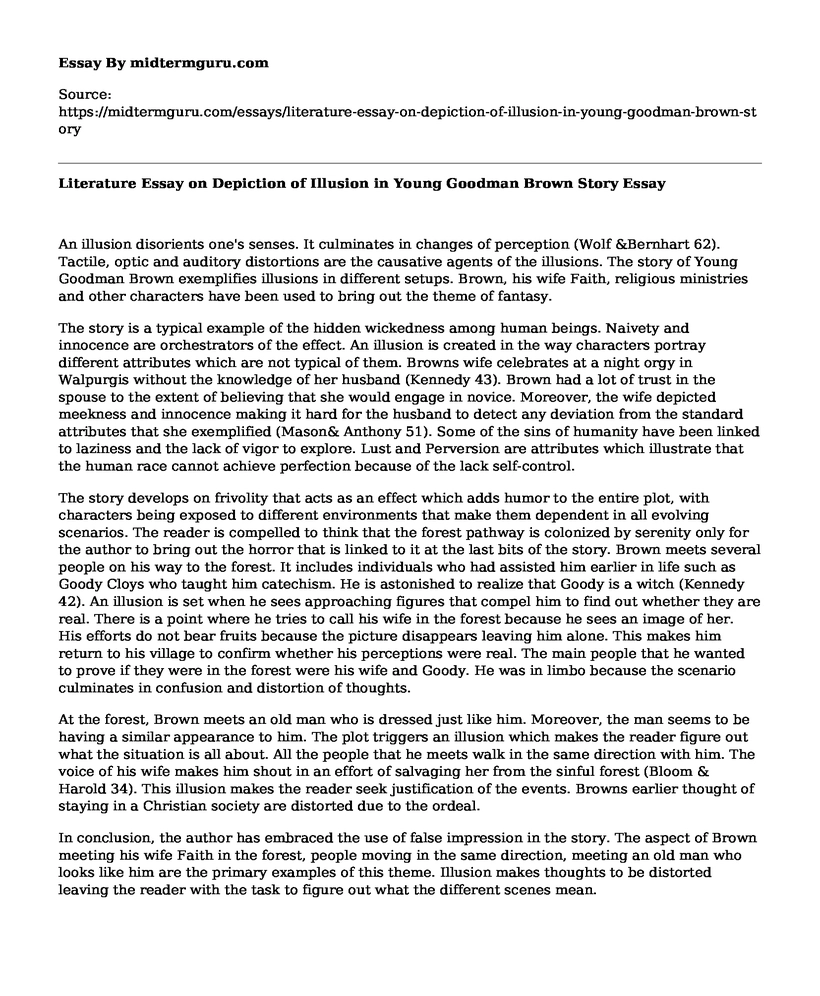An illusion disorients one's senses. It culminates in changes of perception (Wolf &Bernhart 62). Tactile, optic and auditory distortions are the causative agents of the illusions. The story of Young Goodman Brown exemplifies illusions in different setups. Brown, his wife Faith, religious ministries and other characters have been used to bring out the theme of fantasy.
The story is a typical example of the hidden wickedness among human beings. Naivety and innocence are orchestrators of the effect. An illusion is created in the way characters portray different attributes which are not typical of them. Browns wife celebrates at a night orgy in Walpurgis without the knowledge of her husband (Kennedy 43). Brown had a lot of trust in the spouse to the extent of believing that she would engage in novice. Moreover, the wife depicted meekness and innocence making it hard for the husband to detect any deviation from the standard attributes that she exemplified (Mason& Anthony 51). Some of the sins of humanity have been linked to laziness and the lack of vigor to explore. Lust and Perversion are attributes which illustrate that the human race cannot achieve perfection because of the lack self-control.
The story develops on frivolity that acts as an effect which adds humor to the entire plot, with characters being exposed to different environments that make them dependent in all evolving scenarios. The reader is compelled to think that the forest pathway is colonized by serenity only for the author to bring out the horror that is linked to it at the last bits of the story. Brown meets several people on his way to the forest. It includes individuals who had assisted him earlier in life such as Goody Cloys who taught him catechism. He is astonished to realize that Goody is a witch (Kennedy 42). An illusion is set when he sees approaching figures that compel him to find out whether they are real. There is a point where he tries to call his wife in the forest because he sees an image of her. His efforts do not bear fruits because the picture disappears leaving him alone. This makes him return to his village to confirm whether his perceptions were real. The main people that he wanted to prove if they were in the forest were his wife and Goody. He was in limbo because the scenario culminates in confusion and distortion of thoughts.
At the forest, Brown meets an old man who is dressed just like him. Moreover, the man seems to be having a similar appearance to him. The plot triggers an illusion which makes the reader figure out what the situation is all about. All the people that he meets walk in the same direction with him. The voice of his wife makes him shout in an effort of salvaging her from the sinful forest (Bloom & Harold 34). This illusion makes the reader seek justification of the events. Browns earlier thought of staying in a Christian society are distorted due to the ordeal.
In conclusion, the author has embraced the use of false impression in the story. The aspect of Brown meeting his wife Faith in the forest, people moving in the same direction, meeting an old man who looks like him are the primary examples of this theme. Illusion makes thoughts to be distorted leaving the reader with the task to figure out what the different scenes mean.
Cite this page
Literature Essay on Depiction of Illusion in Young Goodman Brown Story. (2021, Jun 17). Retrieved from https://midtermguru.com/essays/literature-essay-on-depiction-of-illusion-in-young-goodman-brown-story
If you are the original author of this essay and no longer wish to have it published on the midtermguru.com website, please click below to request its removal:
- Essay on My Last Duchess by Robert Browning
- Essay on Uncertainty in Spies by Michael Frayne
- Englisf Literature Essay Sample: Hamlet Seeking Revenge for His Fathers Death
- Book Analysis Essay on Citizen by Claudia Rankine
- Kafka's Story: A New Era of Writing in Literature - Essay Sample
- Essay Sample on Evolution of Othello's Character
- Literary Analysis Essay on Foil Characters in Romeo and Juliet







